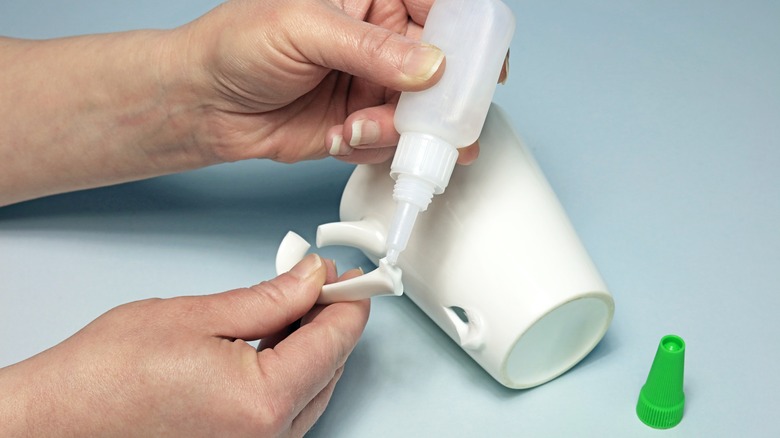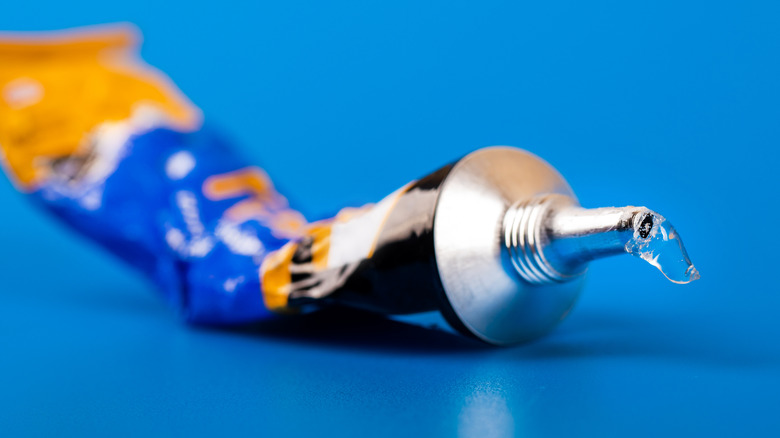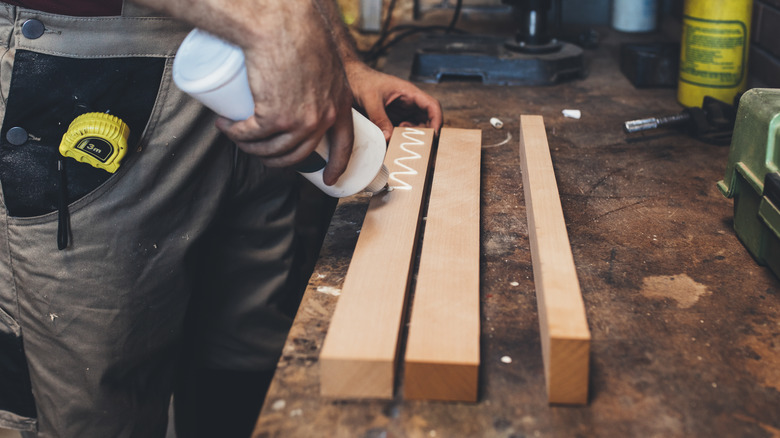The Hidden Downsides Of Using Super Glue To Fix Things Around The House
Super glue likely tops your list of household fix-it tools. It's inexpensive, fast-drying, and compatible with almost any material. Unfortunately, there are also many downsides to using this adhesive besides the seemingly age-old challenge of removing super glue stains from clothing (thankfully, a few kitchen ingredients can do the trick). Aside from its ability to put things back together, super glue is also toxic to inhale, poisonous to the eyes, flammable on certain surfaces, and damaging to the skin (via Medical News Today). Essentially, it shouldn't be placed anywhere besides the item it's meant to fix.
Super glue has been around since the '40s, but it gained popularity during the Vietnam War when soldiers realized that chemicals present in the glue — known as cyanoacrylates — could effectively treat war wounds. Today, super glue is predominantly used for home improvement projects, leaving many homeowners with glue on their skin and a house smelling of toxic fumes. (Tip: If you do get glue on your skin, just reach for a can of WD-40.) Let's explore the hidden disadvantages of using super glue around the house and learn how to use it safely.
Negative effects of super glue
In general, you should never inhale super glue, which is a nearly impossible ask for home improvement enthusiasts who need to use the product on multiple projects. The chemical compounds that make up super glue can cause coughing, shortness of breath, chest tightness, and even asthma attacks, according to the New Jersey Department of Health and Senior Services. If it comes in contact with the skin, the adhesive can cause cracking and peeling, which may require medical intervention. Super glue also has the strength to glue the eyes and mouth shut if used inappropriately or by children. If you accidentally consume it, contact poison control to ensure the chemicals get rinsed out.
Many people are also unaware of adhesive allergies, a form of contact dermatitis that reacts to topical glues by swelling, blistering, and darkening the skin (via Verywell Health). Severe adhesive allergies can cause homeowners to go into anaphylaxis, a life-threatening allergic reaction that results in hives, wheezing, and even loss of consciousness, per Medical News Today. While many adults might prevent this by using gloves and masks, children are especially susceptible to super glue's effects according to the Missouri Poison Center, so keep it somewhere out of reach.
How to use super glue safely
While you should always use super glue with caution, there are a few ways to do so safely. For starters, make sure you're in a well-ventilated area so you're not directly inhaling toxic fumes. Also, make sure you wear a protective mask if you can't control an area's ventilation or if you're working on a stationary project. In such cases, consider turning on a couple of fans to manually ventilate the space. Before you get started on your project, put on gloves and a long-sleeved T-shirt to protect your skin.
You may also benefit from wearing eye goggles, especially if you have sensitive eyes or wear contact lenses. Remove any valuable accessories like rings, watches, and bracelets if you plan to use disposable gloves. If you're working outside, consider wearing old shoes so super glue doesn't accidentally stain a more valuable pair — and so your feet and ankles are protected from spills. When you're done using the product, make sure it's securely sealed before storing it in a safe place. If you do get glue on a surface where it doesn't belong, check out these super glue removal hacks.


